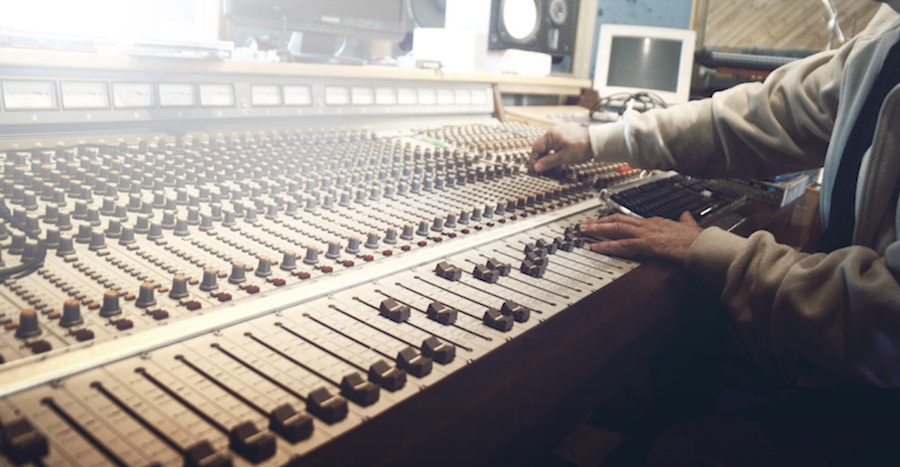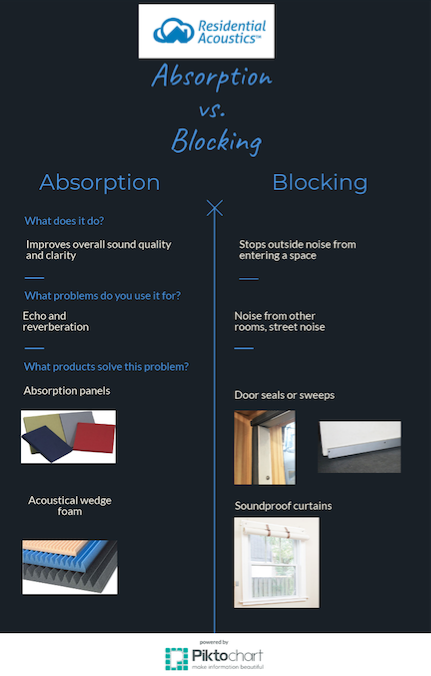No products in the cart.
Achieving Proper Recording Studio Acoustics

28
Nov
There are a lot of misconceptions about sound treatments for proper recording studio acoustics. While many people think sound absorption and blocking are the same, they are actually very different. Different products should be used depending on if you’re looking to absorb or block sound. Read on to learn what each term really means, and what treatments can be used to solve the sound problems you are facing in your recording studio.
Sound Absorption vs Sound Blocking in Recording Studios
First, you will want to determine if your biggest need is sound absorption or sound blocking. A lot of folks come to me with misconceptions about what will reduce volume vs which treatments can improve recording quality.
If you’re having issues with feedback, reverb, clarity or just generally “good sounding” music, then you’ll benefit more from using sound absorption to treat your studio. On the other hand, if your neighbors down the street are complaining about your drums and other instruments, then sound blocking is the answer.
Sound Absorption in Recording Studios
Sound absorption products are commonly used in spaces where echo and reverberation are issues. For example, if you’ve ever gone out to eat at a super busy restaurant you probably had to yell at the people you were eating with so that they could hear you. That happens because lively restaurants are usually pretty large and filled with a lot of hard surfaces – the perfect recipe for echo and reverb issues.
While you might not notice a lot of echo in your recording studio with your own ears, the microphone you use is probably going to pick that up and when you go back to listen to your recording. If you want your recordings to sound better, you’ll want to get rid of some of the hard surfaces in your studio.
In order to do this you would use absorptive products such as acoustic panels or even by just putting more soft surfaces in your recording area. These types of products will help to absorb sound to take away the echo that might otherwise come through in your recordings.
Sound Blocking in Recording Studios
Blocking involves stopping outside noise from entering the recording space altogether. If you have a problem with outside noise in your studio, you should be looking to block sound. Blocking materials tend to be heavy and dense.
For example, say your recording studio doubles as your bedroom and you’ve got some kids and pets running around your house all the time. You’ll need some sound blocking materials to make sure that sound doesn’t make its way into your recording.
This situation would most likely call for some of our soundproofing curtains. They have an STC rating between 20 and 26 and block out between 60% and 90% of outside noise. If you do consider other sound blocking products, just be sure they have an STC rating so you know for sure that they’re able to block sound.
Acoustically Treating Your Recording Studio
Now, we’ve suggested some sound absorbing and blocking products and now we’ll tell you how you can actually implement them in your recording studio.
Absorption panels are hung on the wall and made to trap and contain sound waves, minimizing echo and reverberation. They improve speech intelligibility, get rid of background noise, and make for a clearer sound while recording. Check out some of our acoustic absorption panels.
Acoustical wedge foam is a low cost, easy to install solution to noise problems in your recording studio and can be hung with any foam-approved construction adhesive. It reduces reverberation, improving acoustics and greatly increasing sound quality in the space.
You can use door seals and door sweeps if sound is seeping into your recording through the door, seals or sweeps are a great solution for you. Door seals are installed around the perimeter of the door, preventing noise from coming into the studio through cracks or gaps around the door. Door sweeps are placed underneath the door, closing the gap to the floor and stopping noise from traveling underneath the door.
Our soundproof curtains can be hung over any window in your studio and seals around the window frame, deflecting sound waves. This prevents outside noise from entering the room, reducing disturbances when you are trying to record.
While exterior noise prevention means you won’t need as many “takes”, soundproofing curtains in your studio also mean that you’ll be less likely to disrupt your neighbors, since they are equally effective at keeping sound in!
Proper Recording Studio Acoustics
Now that you know the difference between sound absorbing and sound blocking you can start your little home project to improve your recording studio acoustics.
Did any of these tips help improve the sound quality of your recording studio? If so, let us know in the comments below!

